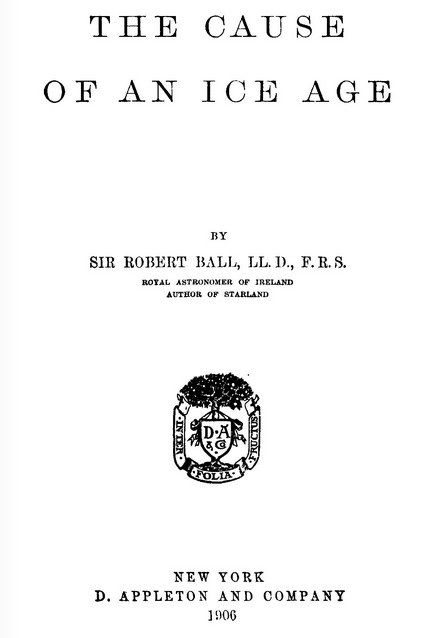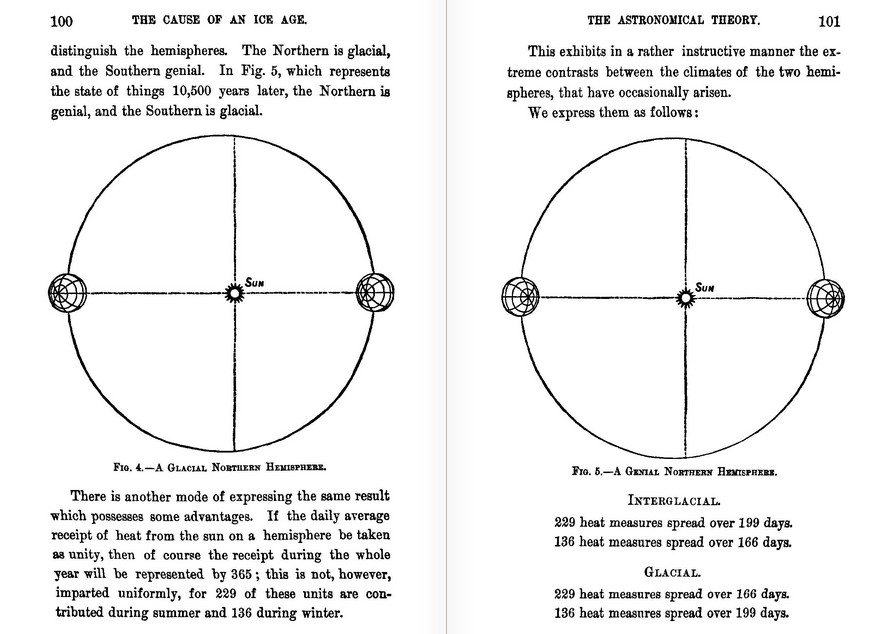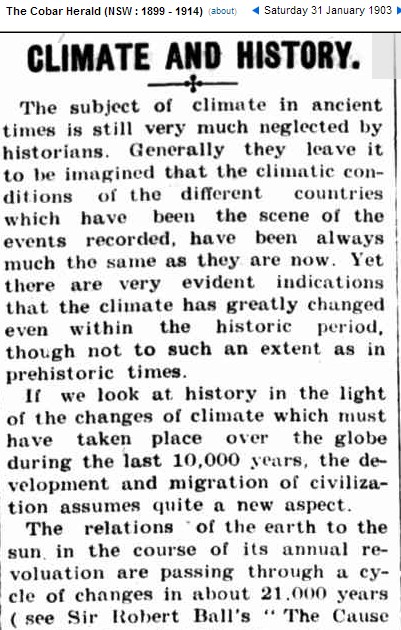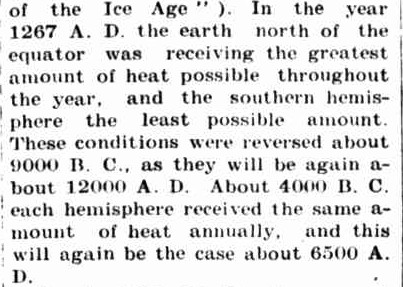It has been known for over 110 years that the primary driver of climate on Earth is variations in the planet’s orbit and rotation. Because the Earth’s orbit is elliptical, some seasons are longer than others. Depending on which way the planet’s axis is tilted at any given time, this can either mean either long summers, or long winters.
Precession of the Earth’s axis over time produces alternating cold and warm periods, and opposite in the opposite hemispheres.
Long before climate science went completely brain dead under the stewardship of James Hansen, this was well understood, and was also understood to be the cause of the MWP – which the Climategate criminals have since tried to erase.






That was discounted as unimportant by the IPCC. Pages and pages were written that dismiss that argument. Otherwise, it would have made its way into the models. They claim that those factors were taken into consideration.. the warming is unprecedented and not the cause of any natural forcing. That’s what they said. I think you can guess which side I was arguing.
I think they really missed a bet there. Just think of the massive NASA and research budgets to change the Earth’s orbital eccentricity!! And it would have the benefit of being scientifically provable from empirical data!
But then snake oil salesmen are only interested in the sale, not the product.
Reblogged this on Centinel2012 and commented:
Apparently we have forgotten a lot. We knew more a hundred years ago it would seem. I have been working on this aspect for almost a decade now and I agree this is more right than any of the believers at NOAA, NASA as well as the British counter parts and the IPCC.
The deliberate dumbing down really got moving about 100 years ago.
Knowledge of natural cycles has been exploited for thousands of years so one man can rule over over another.
This blog is just ‘the place to be’ for intelligent people.
Wish that we were a political movement with Gail to run up against Hillary. Bubba & Hillary Clinton would be trying to hide somewhere in Dogpatch, Arkansas. 😉
To think that nothing other than human action is responsible for a change in climate in the last 150 yrs is nothing but hubris. That somehow, in a period so short, it’s less than a blink to the geological timescale of the planet, humans have supplanted the natural drivers of climate so completely as to be our downfall, is beyond stupid.
The only real impact humans are having is releasing the CO2 that was bound up in coal back to the atmosphere. This is a VERY GOOD THING!
Carbon starvation in glacial trees recovered from the La Brea tar pits, southern California.
The Philosophical Transactions of The Royal Society – Biological Sciences: Carbon dioxide starvation, the development of C4 ecosystems, and mammalian evolution
Smithsonian Environmental Research Center: Almost all plant life on Earth can be broken into two categories based on the way they assimilate carbon dioxide into their systems. C3 plants include more than 95 percent of the plant species on earth. (Trees, for example, are C3 plants.) C4 plants include such crop plants as sugar cane and corn. They are the second most prevalent photosynthetic type…. The Smithsonian practice a bit of misdirection per usual by leading people to believe C4 plants are crop plants and CO2 increases will only benefit C3 plants endangering C4 plants and by implication our food supply.
C3 plants include the cereal grains such as wheat, rice, barley, oats as well as peanuts, cotton, sugar beets, tobacco, spinach, soybeans. Most trees are C3 plants. Most lawn grasses such as rye and fescue are C3 plants. link
I’m glad you brought that up. I keep finding posts from time to time raving that higher CO2 levels will favor the “wrong kind” of plants and damage the “good” ones. Apparently that, like everything else related to AGW, is pure bunkum.
Of Course our buddies over at SkS will tell us extra CO2 is BAD for plants for example:
There are even studies “proving” CO2 is ‘Bad.’ WUWT had a thread Now it’s more CO2 that will threaten crops “….read below the claims made in this UC Davis press release….” (CO2 has to be found purely EVIL and have no redeeming characteristics.)
Dave Springer @ May 14, 2010 at 6:33 pm shows how they purposefully skewed the results.
It would seem CAGW ‘science’ Is the science of misdirection and propaganda and not the science of the earth’s climate.
MORE:
Randall J. Donohue et. al. – 31 May, 2013
I’ve only been following this blog for a month or so, but this may be your beat post yet….
I think this is true for me because it’s something I hadn’t factored in. While I know that like the output of my furnace, the energy received from the Sun and it’s 11 year cycle (solar min-max) controls all things heat related on the earth. The elliptical orbit and relative tilt of the earth had never occurred to me.
This point along with the very easy to prove fact that CO2 is not a “greenhouse” gas, should be repeated again and again. I’ve converted many of the low information crowd with the simple CO2 discussion. Just by pointing out the difference between CO2 and CO, and how the former makes green stuff greener. And the ice core samples which were inverted (CO2 in relation to heat) for the school textbooks.
Issac Newton figured out elliptical orbits in 1687. With the earths tilt being documented at least 100 years before that, this info has been available for well over 300 years. Having already ridden around the Sun a little over 50 times myself, and just finding this out now. I’m feeling a little slow here….. ;p
Matt,
you might want to read the following:
A History of Solar Activity over Millennia.
http://arxiv.org/pdf/0810.3972.pdf
The alternate theory: The Antithesis
http://wattsupwiththat.com/2010/12/30/the-antithesis/
New Geologic evidence of very very quick climate changes.
http://wattsupwiththat.com/2011/01/05/on-“trap-speed-acc-and-the-snr/
The End Holocene, or How to Make Out Like a ‘Madoff’ Climate Change Insurer:
http://wattsupwiththat.com/2012/03/16/the-end-holocene-or-how-to-make-out-like-a-madoff-climate-change-insurer/
The most chilling paper is:
Can we predict the duration of an interglacial?
P. C. Tzedakis, E.W. Wolff, L. C. Skinner, V. Brovkin, D. A. Hodell, J. F. McManus, and D. Raynaud
And the WUWT discussion: http://wattsupwiththat.com/2012/10/02/can-we-predict-the-duration-of-an-interglacial/
(links to pdfs at WUWT)
“beat”… lol… Best post yet….
I never noticed your typo until you just mentioned it. As one who often has many in things I write, I can relate. And I agree that this is a great post.
As I’m fond of saying, especially in chat rooms, “Don’t worry, typo is spoken here.”
It’s the ‘not typos’, lack of care to actually find the correct spelling, that really gets me worked up.
It is spotting the typo a split second AFTER pushing the Post Comment button that I find so frustrating.
No mater how many times I might poof freed I always spot the blooper AFTER I press the button.
And since WP doesn’t allow editing…it makes us all look like illiterate idiots at times. (I really do need a new keyboard…the ‘i’ key on this one sticks and so many times I screw up something else getting rid of all the extra ‘i’s.)
Don’t mis these:
http://stevengoddard.wordpress.com/2012/07/25/history-of-how-this-fraud-was-perpetrated/#comment-105338
https://stevengoddard.wordpress.com/2014/07/20/quick-summary-of-ncdc-data-tampering-forensics/
https://stevengoddard.wordpress.com/2014/07/20/something-seriously-wrong-at-ushcn/
http://stevengoddard.wordpress.com/2014/03/27/ushcn-has-tripled-and-shifted-their-adjustments-since-1999/#comment-331836
I came late to that great web site. I visit it daily now. The numbers fraud has been pretty easy to note over the years (Briffa’s trees, etc.) but the Goddard site goes the whole mile in displaying the heinous and flagrant numbers fraud.
Reblogged this on the WeatherAction Blog.
Perhaps this could explain it why so many of the “educated” buy into CAGW. Imagine Harvard grads never having the curiosity to wonder what a solstice is? Never in their lives observed that the path of the ecliptic changes during the year? Never bothered to try and understand what the tropic lines on a globe or map represent? http://www.youtube.com/watch?v=p0wk4qG2mIg#t=29
Great point. Maybe we should remove all the clocks from the universities and install sun dials in their place.
Well my point is the lack of general education and the lack of curiosity of the students no matter what field of study they may have chosen outside of the sciences. Even if not taught in formal setting about such things a student should try to learn and understand the fundamentals of the mechanics of the world they live on.
For example a whole lot of people who live in the northern hemisphere know what the Polaris/the north star is and that it can be used for navigation but how many people can pick it out in the night sky? Very very few from my own experience.
Curiosity. The desire to learn. Is what is lacking here in addition to the lack of wisdom to understand that just because you have a Sheepskin from an Ivy league school or any other it does not make you knowledgeable about the things which you have not learned.
The 36,000 year cycle is the creator and destroyer of religions, too. The North Star shifts over time from star to star thanks to the earth’s wobble. Nothing is stable which is why this push to have climate frozen (literally) in one spot is so very insane.
Hope you’re a fan of “yea but’s” lol
But I’m pretty sure the north star isn’t actually part of any religion beyond the astrology one…
In some ancient religions Sirius was the big wazzoo.
Philistines I say….. ;p
try to get anyone to tell you what the ideal climate temperature is. Then try to get the entire scientific community to agree to it.
For extra credit, then try to get them to agree to a way to measure it. (think that one over carefully, not as easy as it sounds)
Scientists in the pre-satellite era knew what they were talking about. They understood Mann-made Global Warming before he was born. This is a great article.
15 October 1951 – The Worker (Brisbane)
“World is Warming
…
THIS climatic fluctuation which began a century ago and has become more noticeable in the last 20 years has been discussed since the 1920’s almost exclusively in scientific circles. Recently, however, it has become a subject of more than academic interest. The scientists hasten to assure the world that there is no immediate cause for alarm. The change is merely part of the endless cycle of heat and cold which started with the last ice age about one million years before the birth of Christ.
There is not yet reason to assume, say the scientists, that the mercury in the world’s thermometers will now rise any higher than it would have risen during two or three other un- usually warm periods since the be ginning of our calendar. These were not years which scorched the globe as fatally as the ice ages had frozen it. But they were years of mild winters and hard summers. In some parts of Central Europe, Africa and the Americas they brought drought.”
http://trove.nla.gov.au/ndp/del/article/71392865
Once again we have to reinvent the wheel. Between the thermodynamics folks and physics and statistics folks we have shown over and over that Mann-made climate is a joke of epic proportions.
——————-
‘Testing An Astronomically Based Decadal-Scale Empirical Harmonic Climate Model vs. The IPCC (2007) General Circulation Climate Models’ by Nicola Scafetta, PhD